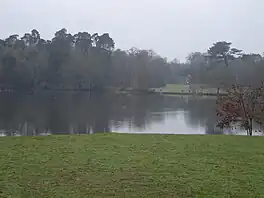Virginia Water Lake
Virginia Water Lake lies on the southern edge of Windsor Great Park, in the borough of Runnymede in Surrey and the civil parishes of Old Windsor and Sunningdale in Berkshire, in England. It is a man-made lake taking its name from a natural body of water of the same name. There is a village of Virginia Water which stretches out to the east of the lake. The grounds of the lake, nearby Fort Belvedere, and the Clockcase are all Grade I listed on the Register of Historic Parks and Gardens.[1]
| Virginia Water Lake | |
|---|---|
 | |
 Virginia Water Lake | |
| Location | Berkshire |
| Coordinates | 51°24′40″N 0°36′10″W |
| Type | artificial lake |
| Primary inflows | River Bourne |
| Primary outflows | River Bourne |
| Basin countries | United Kingdom |
| Settlements | Virginia Water |
History
Virginia Water Lake was originally little more than a stream, which existed from at least the 17th century and may well be named after Elizabeth I, the Virgin Queen, although this is not certain. The lake itself was begun in 1746 by William, Duke of Cumberland who was then Ranger of the Park. His own regiment, the 23rd Regiment of Foot, undertook the construction.[2] The original lake was much smaller than the current form, and was destroyed in a flood in 1768. In 1780 Paul and Thomas Sandby began construction of a much larger lake at the site, and went on to add an artificial waterfall, Meadow Pond and Obelisk Pond.
Among the lakeside features are the 30-metre-high (100 ft) high Canadian totem pole, carved by Mungo Martin, Henry Hunt, and Tony Hunt Sr., commemorating the centenary of British Columbia, and a collection of ornamental Roman ruins, transported from the site of Leptis Magna (modern-day Al-Khums) in 1816 and installed at Virginia Water in 1826.[3] In 2022, the Libyan government questioned the legality of the ruin's acquisition and asked for them to be returned.[4]
In 1834, a miniature sailing frigate, the Royal Adelaide, was constructed at Sheerness for King William IV, was dismantled and transported overland to Virginia Water where it was reassembled and launched for sail training of the royal princes. It was fully rigged, was 50 feet (15 m) long and 15 feet (4.6 m) in beam, displacing 50 tons burden, and was armed with 22 working miniature cannons. It was broken up in 1877 but the guns were donated to the Royal Yacht Squadron at Cowes Castle.[5]
During World War II, the lake was drained, as its obvious shape provided enemy guidance at night to Windsor and other important military targets in the area.
The River Bourne provides the water for the lake and it exits the lake at the eastern end after the cascading waterfall. The circuit around the lake is about 4.5 miles (7.2 km), about half is paved and the other half is a "natural" path both providing easy walking conditions even with a pram or pushchair.[6]
In popular culture
The lake has been used for lakeside scenes for the Harry Potter films. The Scottish alternative was deemed unsuitable due to the number of midges. The Lake was also used for scenes in the 2014 film Into The Woods. It was also used as the scene for the drone strike attack scenes in the 2019 action thriller movie Angel Has Fallen.
Gallery
 Waterfall at eastern end of lake
Waterfall at eastern end of lake Virginia Water lake view, 2012
Virginia Water lake view, 2012.jpg.webp) Bridge across Virginia Water
Bridge across Virginia Water
References
- Historic England, "The Royal Estate Windsor: Virginia Water (Including Fort Belvedere and the Clockcase) (1001177)", National Heritage List for England, retrieved 10 February 2016
- https://historicengland.org.uk/images-books/publications/conservation-bulletin-44/cb-44/ p.57
- Cooper, Paul (10 January 2018). "How Ancient Roman Ruins Ended Up 2,000 Miles Away in a British Garden". The Atlantic. Archived from the original on 23 December 2019.
- Simpson, Craig (22 April 2022). "Queen's estate faces legal battle over Libyan 'Elgin Marbles'". The Telegraph.
- "Miniature Frigate Royal Adelaide (1834); Royal/ceremonial vessel; Recreation vessel; Sail training". www.rmg.co.uk. National Maritime Museum. Retrieved 31 March 2020.
- Aba's Walks
Further reading
- South, Raymond (1983). Royal Lake: the story of Virginia Water. Buckingham: Barracuda. ISBN 0-86023-141-0.
- Taylor, W. F. (1800). W.F. Taylor's guide to Windsor Castle, Eton, and Virginia Water: Arranged in the most concise form, and embracing a description of the gold pantry, and the interior of the private apartments, with catalogue of the paintings in the state rooms of the royal residence, with explanatory references to the most attractive and picturesque scenery, and other objects of interest to visitors in the vicinities of Windsor and Eton. Windsor: W.F. Taylor.
External links
- Runnymede borough council - picture of cascading waterfall Archived 19 February 2007 at the Wayback Machine
- "Walk around the lake" (PDF). Archived from the original (PDF) on 6 February 2012.

